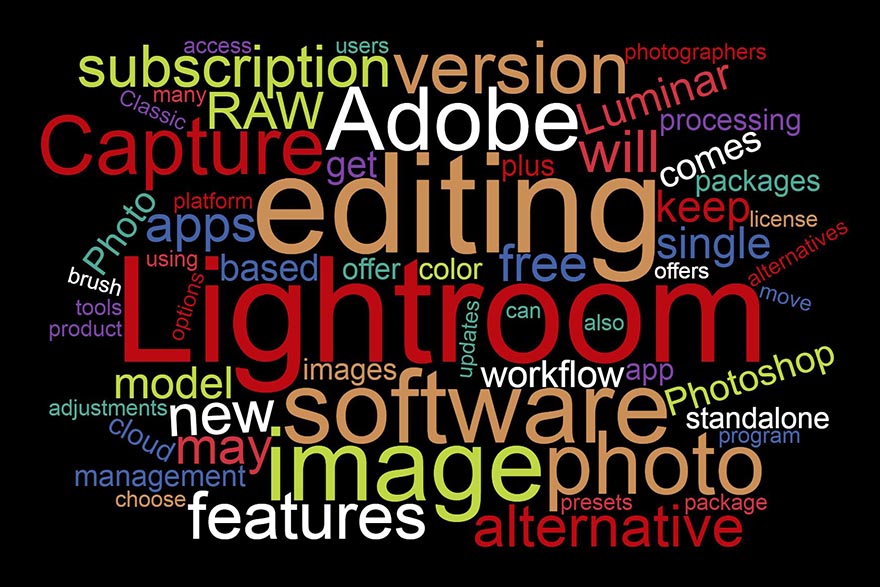 You may have heard the news already, but in case you missed it, the much loved photo editing software, Lightroom is moving to a subscription based model.
You may have heard the news already, but in case you missed it, the much loved photo editing software, Lightroom is moving to a subscription based model.
What does this mean for you? Well, you have three options.
Keep using your desktop based version.Go for the new cloud based model.
Try a Lightroom alternative.
Adobe Lightroom is moving to a subscription based model with monthly fees
The move by Adobe is from software you own (single license) to software you rent (subscription). Announcing the change in October, the photography world reacted in partisanship to the ultimatum. Devotees felt reluctant and hesitant to choose, stay or leave. Many photographers have been using the Lightroom platform for over a decade. The image management and image processing software is more than just an archive and darkroom in a single app. It is a familiar home for professionals and shutterbugs alike. So, this change has drawn a line in the sand for many.
Adobe Lightroom Classic CC
The Lightroom image editing software you know and love is henceforth called Lightroom Classic CC. The latest version of Lightroom 6 was just updated this December. If you have the standalone software you may continue to enjoy this for the foreseeable future. The rub is that at the end of 2017, Adobe will no longer offer bug fixes, version updates, new camera or tech support for this product. Lightroom 6 is the last standalone version from Adobe. Either get the latest version update of Lightroom or keep using your version of Lightroom ad inifinitum. And the crowd goes wild. Some will take the chance and keep the software until the need for progress pushes them into a new direction. It is a fork in the road, keep Adobe Lightroom and choose subscription based service or pick a Lightroom alternative photo editing app.
The rub is that at the end of 2017, Adobe will no longer offer bug fixes, version updates, new camera or tech support for this product
If you stay with Adobe’s Creative Cloud experience, they certainly make it appetizing. You can go Lightroom Classic CC, which as mentioned above is the same program you are accustomed to which will be updated as they roll out with new features. Or you can go the rebranded Lightroom CC, which is integrated across devices and features myriad technological delights. The price for admission is $9.99 monthly with the basic package for either route. You get a choice of 20GB to 1TB of cloud storage dependent on your desire for seamless Lightroom to Photoshop transitions, plus Adobe Sensei (see below), and more.
More info about the Abobe Create Cloud Plans
From there the packages move up to $79.98 per month and have features such as a personal portfolio website, access to the entire selection (20+) of creative apps for desktop and mobile, plus free images to Adobe Stock. They also offer discounted packages for students and teachers, business packages, and packages for schools.
Lightroom CC offers instant updates to new features. Just recently on Dec 11, 2017 they added tone curve, split toning and more to Lightroom to enhance stylization of photos for precision photo contrast control, and application of color tints to highlights and shadows. A huge difference from Lightroom Classic CC to Lightroom CC, is version 7 software to version 1 software. Some may prefer the versatility of more tried and true tech than others.
Organization is one of the main features of Lightroom CC. In the past, one could have vast redundancies with multiple overlapping Lightroom catalogs. Adobe Sensei is a boon by implementing automatic keywords to your photos. This is artificial intelligence applied to searchable keywords where the program will use machine learning to keep you organized. For the moment, Facial Recognition is not part of Lightroom CC, though its likely to be in the future.
On October 18, 2017 Photoshop also got a facelift with a smorgasbord of new features and upgrades once the subscription model was announced. Photoshop CC now has access to Lightroom CC images, plus brush organization, brush performance, brush stroke smoothing, curvature pen tool, group layer arranging, 360 panorama workflow, and more added.
More info about Photoshop Features
More recently in November, Adobe announced another AI technology coming to Photoshop CC called the Select Subject tool, where machine learning identifies image subjects and isolates them from the background for image editing enhancement. This would normally require other tools such as Pen, Magic Wand, or Quick Selection. All these new features are meant to keep users happy by optimizing the subscription choice through more distinctive enhancements.
Skylum Luminar
Now to the Lightroom alternatives. Macphun, which is rebranding as Skylum, is offering Luminar 2018 for Macs … and PCs! CEO Alex Tsepko blogged, “We now have a vision of bringing photographers a truly worthy Adobe alternative.”
Macphun, which is rebranding as Skylum, is offering Luminar 2018 for Macs … and PCs!
This award winning company has been pumping out powerful, innovative photo editing apps for years. Offering numerous free updates to their Luminar photo editor for both computer users, if you already have a Luminar version the upgrade is only $39. Known to be a powerful and intuitive image processing app, you get a Digital Asset Management (DAM) platform that will work with any hard drive or cloud storage you choose, editing of nearly any RAW file, and intelligent filters such as the Accent AI filter.
The RAW engine new to Luminar 2018 has intelligent sharpening, 200% faster RAW opening speeds, real time noise reduction, and advanced color processing. As a standalone photo editing platform for Macs and PCs, this product comes in at $69 with an assortment of free bonuses. Compared to Adobe Lightroom, you get nearly all the features plus many not on Lightroom with a single payment of essentially half the yearly subscription. For those not in love with the subscription model, this offers a wonderful Lightroom alternative. Whether you are editing a single image or batch, whether you like to customize your presets or use the automated filters built-in, whether you are a pro or enthusiast, Luminar has something of value to offer you.
Phase One’s Capture One
Another Lightroom alternative comes from Phase One’s Capture One photo editing software. This image processing software and RAW converter is a layer-centric app affording, you guessed it, a layered editing workflow.
Phase One’s Capture One photo editing software offers a layered editing workflowThere is a 30-day free download if you desire to try it and you get access to all the features and tools. A drawback is that Capture One comes from a medium format camera company so they may not be as quick to add support for newer cameras. This will probably speed up as they are a big contender in the alternative to Lightroom CC market. Lightroom has presets, Capture One has recipes. Lightroom has catalogs, Capture One has sessions. Though Capture One may have fewer presets than Lightroom, it does have the ability to better organize single client images and batch workflow more efficiently. If you are working with a larger set of images, you may greatly appreciate this quality. When it comes to color adjustments, color profiles, local image adjustments, and image sharpening both Lightroom CC and Capture One perform similarly. For lens adjustments, Capture One does have a more extensive distortion correcting feature. As a RAW photo editor, Capture One is excellent and a favorite amongst many photographers. Offering programs for both Mac and PC, to buy a perpetual license with free upgrades, the cost is $299 for the whole program. The current Capture One 11 upgrade costs $119 for existing users. Capture One also offer a subscription service model in addition to buying the standalone product version for $20 monthly which is pricier than Adobe’s Creative Cloud family package.
Free Options
There is no shortage of free options too for alternatives to Lightroom CC. Some are open source with legions of loyal followers continuously on the forums sharing techniques and best methods. The tricky part is finding a total package. Many are great RAW photo converters, and that is all. Others are remarkable image editing software, and that is all. Sure, the platforms described here are not free, but they are some of the best out there. When it comes to photo editing software, RAW image tools, and image management apps, we believe Skylum’s Luminar 2018 and Phase One’s Capture One rank at the top of the heap for Lightroom alternatives.

